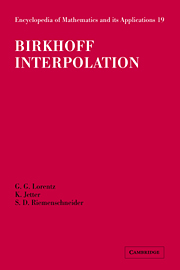Book contents
- Frontmatter
- Contents
- Editor's Statement
- Preface
- Introduction
- Chapter 1 Basic Definitions and Properties
- Chapter 2 Further Elementary Theorems
- Chapter 3 Coalescence of Rows
- Chapter 4 Applications of Coalescence
- Chapter 5 Rolle Extensions and Independent Sets of Knots
- Chapter 6 Singular Matrices
- Chapter 7 Zeros of Birkhoff Splines
- Chapter 8 Almost-Hermitian Matrices; Special Three-Row Matrices
- Chapter 9 Applications
- Chapter 10 Birkhoff Quadrature Formulas
- Chapter 11 Interpolation at the Roots of Unity
- Chapter 12 Turán's Problem of (0, 2) Interpolation
- Chapter 13 Birkhoff Interpolation by Splines
- Chapter 14 Regularity Theorems and Self-Dual Problems
- Bibliography and References
- Symbol Index
- Subject Index
Chapter 8 - Almost-Hermitian Matrices; Special Three-Row Matrices
Published online by Cambridge University Press: 05 April 2013
- Frontmatter
- Contents
- Editor's Statement
- Preface
- Introduction
- Chapter 1 Basic Definitions and Properties
- Chapter 2 Further Elementary Theorems
- Chapter 3 Coalescence of Rows
- Chapter 4 Applications of Coalescence
- Chapter 5 Rolle Extensions and Independent Sets of Knots
- Chapter 6 Singular Matrices
- Chapter 7 Zeros of Birkhoff Splines
- Chapter 8 Almost-Hermitian Matrices; Special Three-Row Matrices
- Chapter 9 Applications
- Chapter 10 Birkhoff Quadrature Formulas
- Chapter 11 Interpolation at the Roots of Unity
- Chapter 12 Turán's Problem of (0, 2) Interpolation
- Chapter 13 Birkhoff Interpolation by Splines
- Chapter 14 Regularity Theorems and Self-Dual Problems
- Bibliography and References
- Symbol Index
- Subject Index
Summary
INTRODUCTION
Several authors have tried to study classes of matrices, of modest generality, that contain the matrices (1.3.7) as special cases. The hope was that some insight into the general problem might be gained by deciding the regularity problem for this class. The failure to find a complete solution for even a relatively simple class of this type illustrates the complexity of the general problem, and to some extent justifies its probabilistic reformulation in §6.4.
A matrix E is almost Hermitian if all of its rows are Hermitian except for one interior row. A subclass consists of the three-row matrices E(p, q; k1, …, ks) where p and q are the lengths of the Hermitian first and third row while 0 < k1 < … < ks are positions of 1's in the second row. We have then p + q + s = n + 1, and we shall always assume 1 ≤ p ≤ q. The regularity problem is not completely solved even for matrices E(p, q; k1, k2).
For almost-Hermitian matrices, many useful results follow from a representation of D(E, X) given by Theorem 8.1. Most notable are a strong singularity criterion due to Lorentz [91] and DeVore, Meir, and Sharma [26] in §8.2 and the reciprocity theorem of Drols [29] in §8.3.
Sections 8.4–8.6 deal with the special matrices E(p, q; k1, k2). In §8.4 we give the “chasing method” of Lorentz, Stangler, and Zeller [104] in a more geometric form. This solves the problem except for the two cases, (8.2.11) and (8.2.12). The second of them admits a complete solution.
- Type
- Chapter
- Information
- Birkhoff Interpolation , pp. 100 - 120Publisher: Cambridge University PressPrint publication year: 1984

